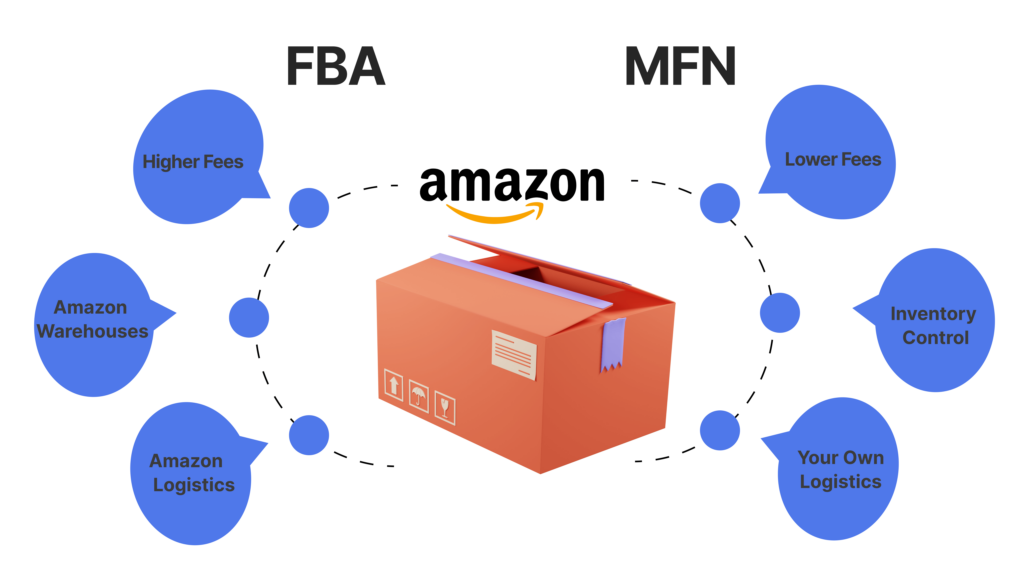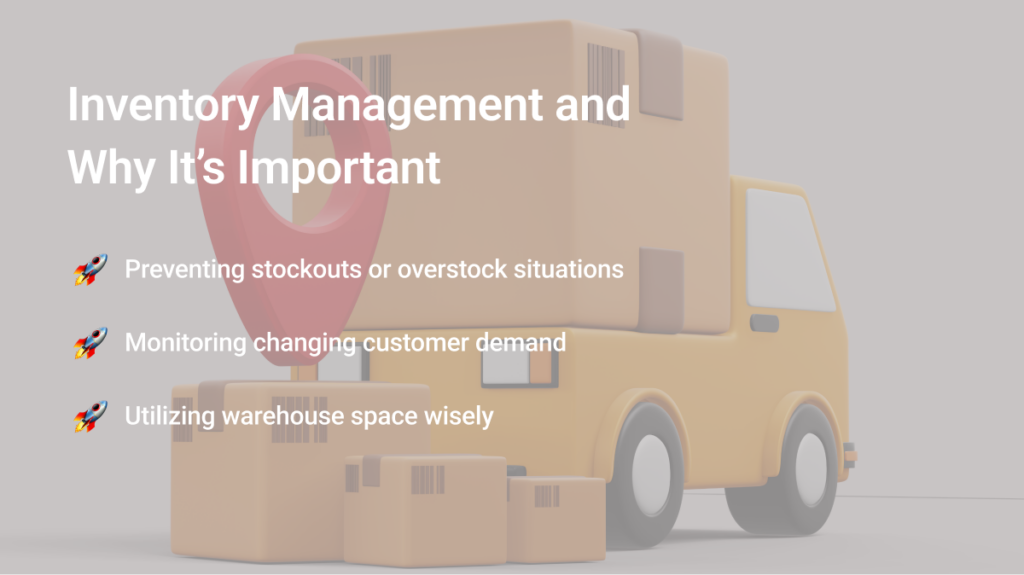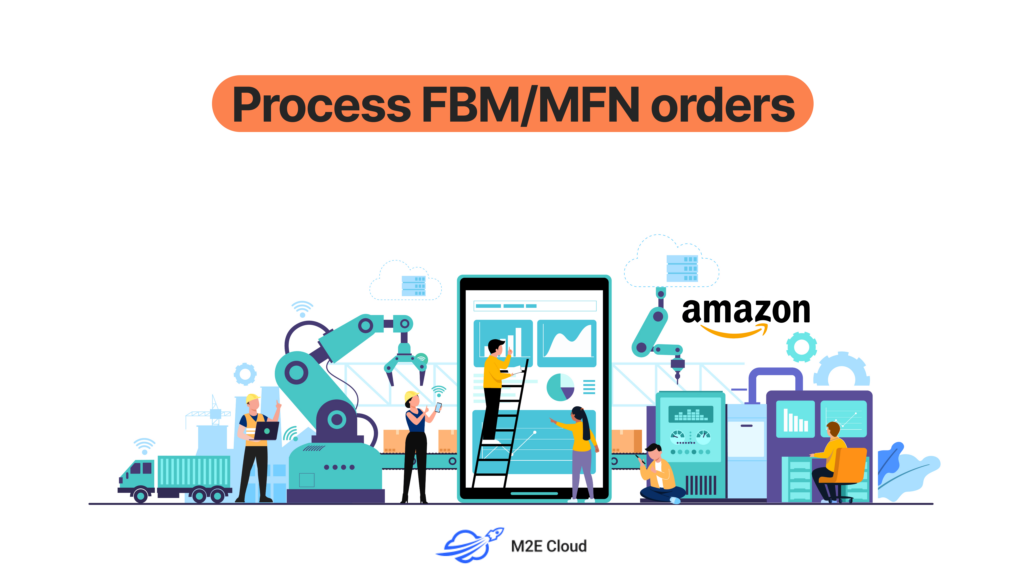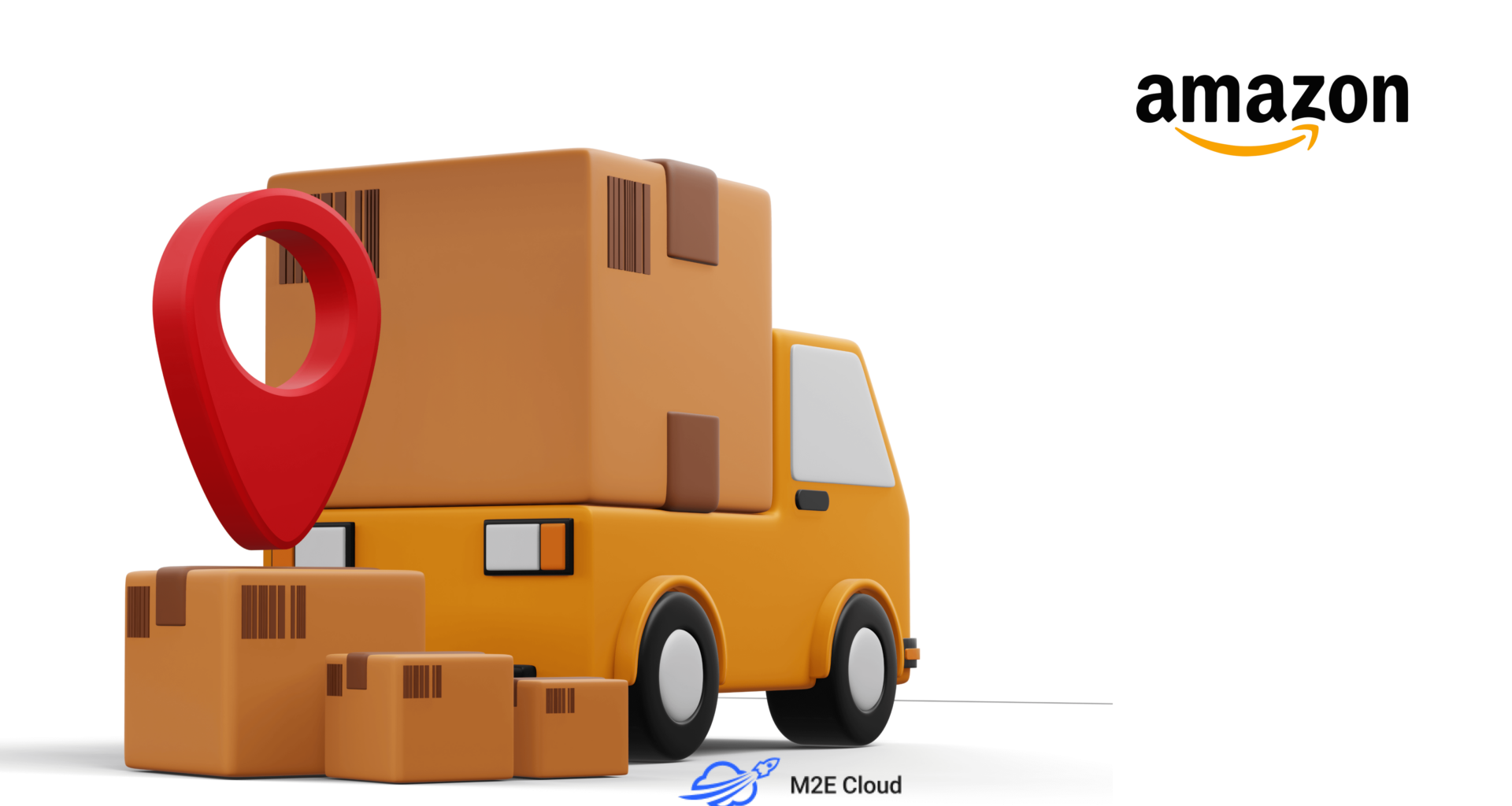Ever wondered how some Amazon sellers wield control over their destiny in the vast marketplace, while others seem lost in the shuffle? The secret might lie in a strategic choice between Merchant Fulfilled Network (MFN/FBM) and Fulfillment by Amazon (FBA). Curious to unravel the mystery of ‘What is FBM/MFN?‘ Join us on a journey where your fulfillment decisions become the compass guiding your success on Amazon’s digital shelves. Ready to discover the game-changing insights that could set your business on a new trajectory?
Let’s quickly go over the main terms:
– Fulfilled by Merchant (FBM), or Merchant Fulfilled Network (MFN), is an order fulfillment approach on Amazon where sellers independently handle all aspects, including inventory storage, packaging, and direct shipping to customers. This method grants sellers complete autonomy in managing logistics and engaging with customers throughout the fulfillment process.
– Fulfillment by Amazon (FBA), or Amazon Fulfillment Network (AFN), is like having a personal assistant for sellers. You send your products to Amazon, and they handle everything – storing, packing, shipping, talking to customers, and dealing with returns. It’s a convenient way to sell more and reach Prime customers without getting bogged down in the details.
What is MFN on Amazon?
Fulfilled by Merchant (FBM), or Merchant Fulfilled Network (MFN), allows you to run your own store within Amazon. With FBM/MFN, you take charge of tasks such as maintaining inventory, packaging, and shipping, as opposed to Amazon handling these aspects for you.
In FBM/MFN, direct communication with customers is a key aspect. You engage with them, addressing inquiries, providing order updates, and assisting with any issues, fostering a more personalized connection with your buyers.
Regarding shipping, you have the flexibility to set pricing and determine delivery speed according to your preferences. Unlike Fulfillment by Amazon (FBA), where Amazon manages everything, FBM/MFN puts you in control.
In terms of costs, FBM/MFN provides more autonomy. Amazon doesn’t levy charges for the services you perform, allowing you to optimize your business operations in a cost-effective manner.
In essence, FBM/MFN is akin to operating your own shop on Amazon, giving you control over operational details, direct customer interactions, shipping policies, and cost management.
What is the difference between FBA and FBM/MFN?

Let’s delve into the crucial distinctions between both options, so you can select the optimal approach for your business. FBM might suit you if:
- You’re not selling a ton of products.
- Your products are big or heavy.
- You have enough room to keep your products.
- Your stock levels aren’t too large.
- Your business doesn’t require advanced fulfillment services.
- You prefer handling customer service and returns yourself.
- Your logistics are running well.
- Your items need specific temperature conditions.
Fulfillment by Amazon (FBA) is akin to a comprehensive service center for sellers. Utilizing FBA, sellers place their merchandise in Amazon’s warehouses, and Amazon oversees all aspects – ranging from packaging and dispatch to managing customer service and processing returns. It represents an intelligent option for merchants grappling with the intricacies of e-commerce, delivering a convenient and expandable solution by leveraging Amazon’s resilient logistics network. Consider FBA If:
- Your products fly off the virtual shelves.
- You have a limited storage room.
- Handling order fulfillment independently is a challenge for you.
- You want fast shipping with potential cost savings.
- Your logistics system isn’t fully established.
- You have restricted capabilities for customer support and product returns.
Ultimately, choosing between MFN (FBM) and FBA depends on your specific business needs and goals.
Breakdown of Amazon FBM Fees
For sellers opting to fulfill orders themselves, Amazon FBM fees encompass various costs that can impact overall profitability. It’s essential to understand these charges for accurate pricing and decision-making:
1. Monthly Subscription Fee
– Pro Plan: $39.99 per month.
– Individual Selling Plan: No monthly fees.
2. Per Item Selling Fee
– Pro Plan: No per-item fee.
– Individual Seller: $0.99 for each product unit sold.
3. Referral Fee. Amazon deducts a referral fee, typically 15% of the total sales price. However, this percentage varies across product categories, ranging from 6% to 45%. See the category-specific table for referral fee details.
4. Shipping Fee. Unlike FBA, FBM sellers need to manage shipping fees separately, either absorbed by the seller or charged to the customer.
Additional Fees for FBA Sellers
If you go for FBA, there are extra costs to keep in mind:
- Labeling Fee. Stick to Amazon’s labeling rules, and you can either use Amazon’s service or label items yourself.
- FBA Packaging Fee. You can pay Amazon to pack your stuff or do it on your own, but follow Amazon’s rules to avoid extra fees for poorly packed items.
- Returns Processing Fee. Returning items is usually free, but if products need extra handling, there might be fees.
- Long-term Storage Fees. If your items don’t sell for more than six months, you might face extra charges.
- Stock Removal Fee. If you want to get rid of unsold items, removing them from Amazon’s warehouse could cost you.
Before switching from FBM to FBA, sellers must be aware of these additional fees. A thorough cost comparison, including ad costs, shipping costs, and FBA fees, is essential. Utilizing tools like the Amazon FBA calculator and Amazon ACoS calculator by SellerApp can provide valuable insights into upfront costs, FBA fees, and estimated sales, aiding in informed decision-making. You can read more about Amazon fees here.
What is important to decide when choosing an FBM?
While FBA is a popular choice, FBM provides a distinct alternative. Let’s explore who this approach is truly suitable for and how it empowers sellers with a unique set of advantages:
- Logistical Autonomy. FBM/MFN is suitable for sellers with established logistics or unique product requirements that may not align with the FBA model.
- Cost Considerations. Sellers should weigh the costs associated with storage, packaging, and shipping to determine the most cost-effective fulfillment method for their business.
- Customer Experience. Success with FBM/MFN requires a commitment to providing excellent customer service, timely shipping, and efficient order handling.
In essence, FBM/MFN empowers sellers to operate their fulfillment processes, offering a level of control and customization that aligns with their business model and logistical capabilities. Understanding the nuances is crucial for sellers seeking a personalized approach to their Amazon business.
How to Easily Create FBM/MFN Listing
Listing products on Amazon is a nuanced process that goes beyond a simple inventory upload, especially in the realm of FBM/MFN. Different methods come into play, depending on whether you’re working with existing listings or creating new ones. To optimize product visibility and attract potential buyers, consider the following tips:
- Descriptive Titles. Craft titles that accurately describe your products.
- Clear Images. Use high-quality images to showcase your products.
- Concise Feature Bullets. Highlight key features succinctly to engage potential buyers.
To simplify product listing, you can use ready-made solutions for Amazon, for example, M2E Sales Channels. By integrating your store with M2E Sales Channels, you can list an unlimited number of products, efficiently handle various business aspects within a single retail business software, optimize listings with Amazon Product Type auto-suggestions, and synchronize inventory levels seamlessly across multiple channels.
Let’s take a closer look at its advantages:
- Effortless Listing Creation. Whether you’re listing existing products in the Amazon catalog or creating new listings for products not yet in the Amazon catalog, this integration empowers you to effortlessly manage and expand your presence on the platform.
- Boosted Online Visibility. Expand your reach across Amazon effortlessly.
- Optimized Inventory Management. Easily manage inventory with simple clicks, grouping products by various parameters, and bulk editing details.
- Auto-Synced Prices. Take advantage of automated price synchronization across various e-platforms, saving time and ensuring consistency.
- Avoiding Stockouts. The software automatically synchronizes inventory levels across all locations and sales channels, preventing overselling.
- Standout Listings. Tailor your listings for each sales channel to engage more buyers with appealing images and descriptions.
Inventory Management and Why It’s Important
Efficient inventory management is the linchpin of success for Amazon sellers, ensuring profitability and customer satisfaction. In the context of MFN, sellers maintain direct control over their inventory, allowing for personalized and flexible management. Integration with advanced multi-channel listing software, like M2E Cloud, brings efficiency. M2E Cloud ensures automated inventory updates, which are crucial for sellers on multiple platforms, preventing overselling and maintaining accurate stock levels.

Why is inventory control important? Efficient inventory management is crucial for Amazon sellers due to the following reasons:
- Align inventory with changing customer demand, especially during peak seasons. Management with M2E Sales Channels guarantees a seamless shopping experience and customer satisfaction.
- Efficient management optimizes returns by avoiding overstocking and utilizing warehouse space wisely. Ensures capital isn’t tied up unnecessarily, contributing to streamlined operations.
- Anticipate and plan for seasonal fluctuations in demand to handle increased customer orders. Proactive planning maintains a seamless shopping experience during holidays or special events.
- Leverage tools like Sales Channels for real-time inventory monitoring. Vigilant monitoring prevents stockouts or overstock situations, enabling agile decision-making.
Process FBM/MFN orders
Navigating the order processing stage is where customer expectations seamlessly merge with operational efficiency. To ensure a positive customer experience, meticulous attention to the picking, packing, and shipping process is essential, adhering closely to Amazon’s guidelines:
- Prompt Fulfillment. If managing fulfillment in-house, prioritize the swift and efficient picking, packing, and shipping of orders. Timely order fulfillment significantly contributes to fostering positive customer experiences.
- Packaging Considerations. When it comes to packaging, make thoughtful choices in selecting the right materials such as boxes, paper, or bubble mailers. Adhering to Amazon’s packing rules not only saves costs but also safeguards items from damage during shipping.
- Tracking Rate Network. Ensure accurate tracking and delivery updates for customers by selecting carriers from Amazon’s approved tracking rate network. This step adds reliability to the shipping process and enhances overall customer satisfaction.
- Shipping Services. Explore Amazon Buy Shipping Services, especially if you lack established shipping logistics. This service not only offers discounted rates but also provides additional safeguards against negative customer feedback and claims, enhancing the overall reliability of your shipping operations.

Enhance your order processing efficiency by integrating M2E Sales Channels. This integration allows for the seamless importation of orders from Amazon into M2E Sales Channels, enabling sellers to ship directly from the app. Tracking details and order statuses will automatically synchronize with both Amazon and the e-commerce platform where the seller manages their business. Sellers can also enable automatic order creation in their e-commerce platform based on Amazon orders, providing a streamlined and automated approach to order processing.
Customer Service
Exceptional customer service is the heartbeat of successful Amazon selling. Going above and beyond in addressing customer inquiries and concerns not only fosters trust but can turn one-time buyers into loyal customers.
Studies indicate that responding to orders within 24 hours leads to fewer negative reviews. Quick responses show dedication and concern. Keep an eye on customer feedback and responses through Seller Central to manage customer service effectively. Taking a proactive approach to customer service helps build a positive seller reputation.
An integral part of customer service is handling returns swiftly and efficiently. Understanding Amazon’s returns policies, charging restocking fees when applicable, and utilizing prepaid returns for seller-fulfilled orders contribute to a seamless returns process.
Final Words
In conclusion, mastering the intricacies of FBM/MFN can be a game-changer for your business. With FBM/MFN, you become the captain of your ship on Amazon. From inventory management to shipment coordination, customer communication to cost control, every aspect is under your command, providing you with unparalleled autonomy.
As you embark on your FBM/MFN journey, consider the advantages of M2E Sales Channels. With a simplified listing process, streamlined inventory management, and the flexibility to adapt to changing customer demands, it becomes the compass guiding your success on Amazon’s digital shelves. Choose empowerment, choose efficiency, and choose M2E Sales Channels to optimize your FBM/MFN experience.

